Selective Intramolecular Dehydrocyclization of Co-Porphyrin on Au(111)
Abstract
1. Introduction
2. Results and Discussion
2.1. Dehydrocyclization of Co(TAP) on Au(111)
2.2. Intermediates of the Dehydrocyclization Reaction
2.3. Intra and Inter-Molecular Reaction Selectivity
3. Materials and Methods
4. Conclusions
Author Contributions
Funding
Acknowledgments
Conflicts of Interest
Appendix A

Appendix B
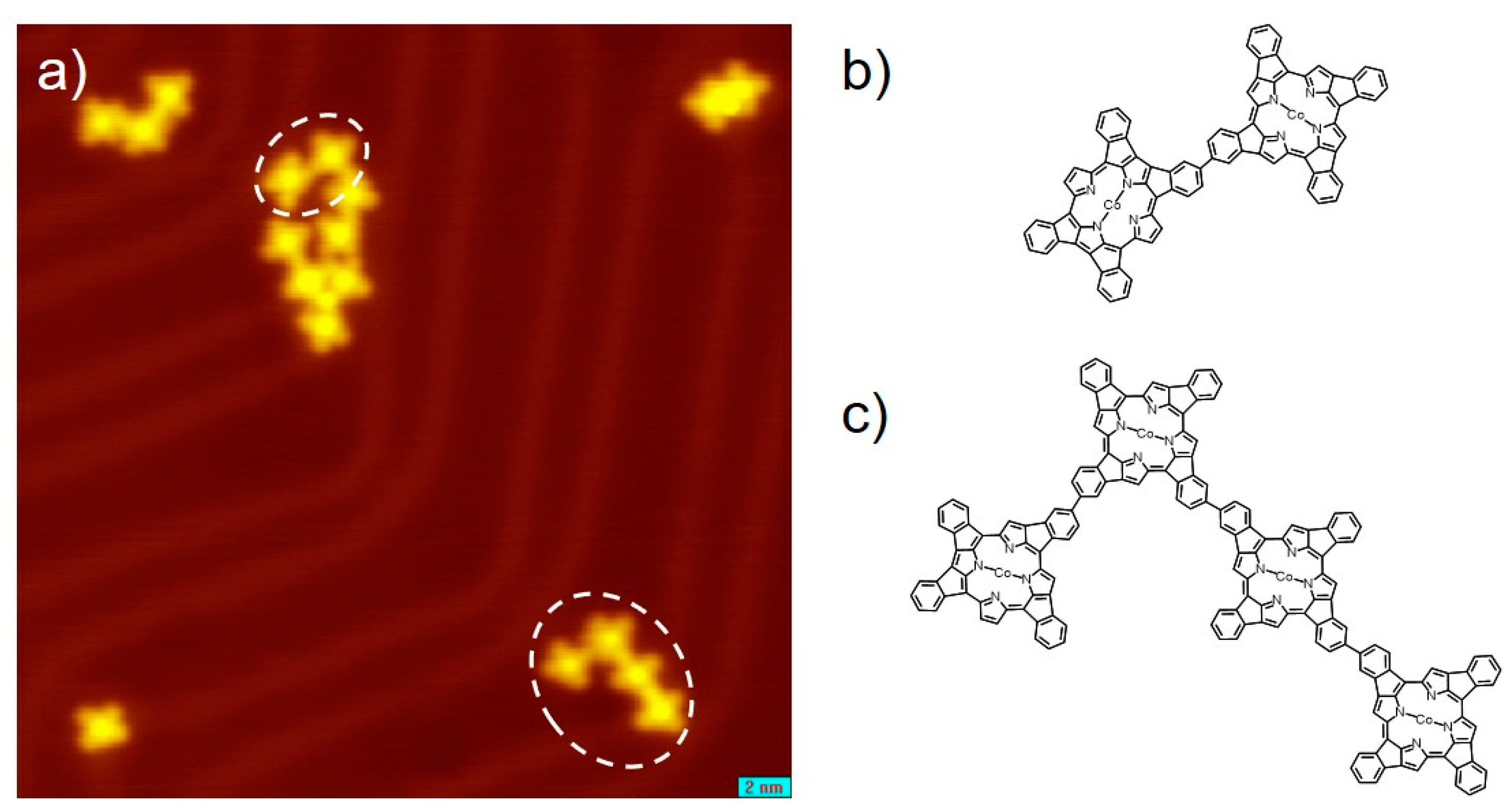
Appendix C
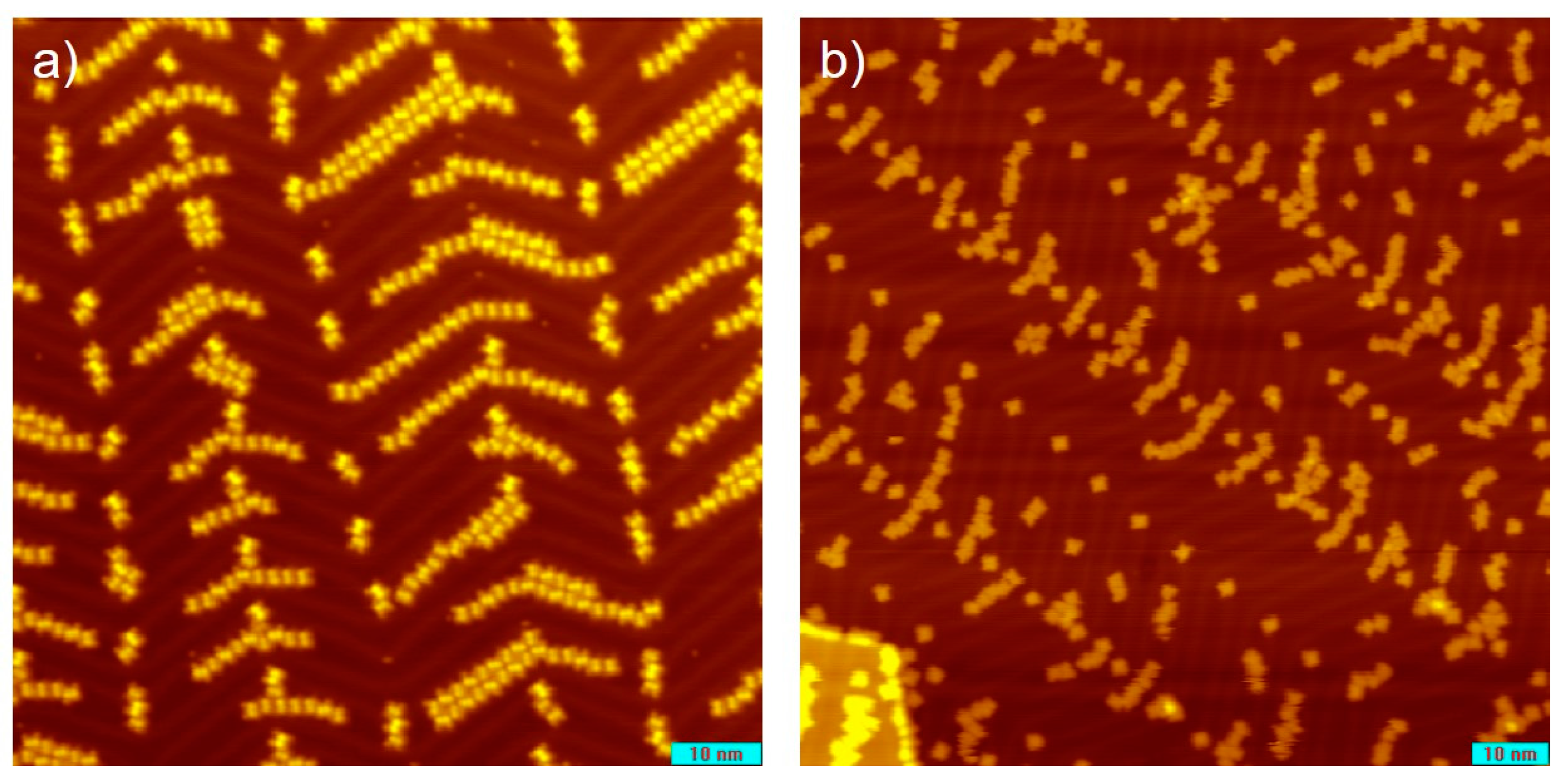
Appendix D
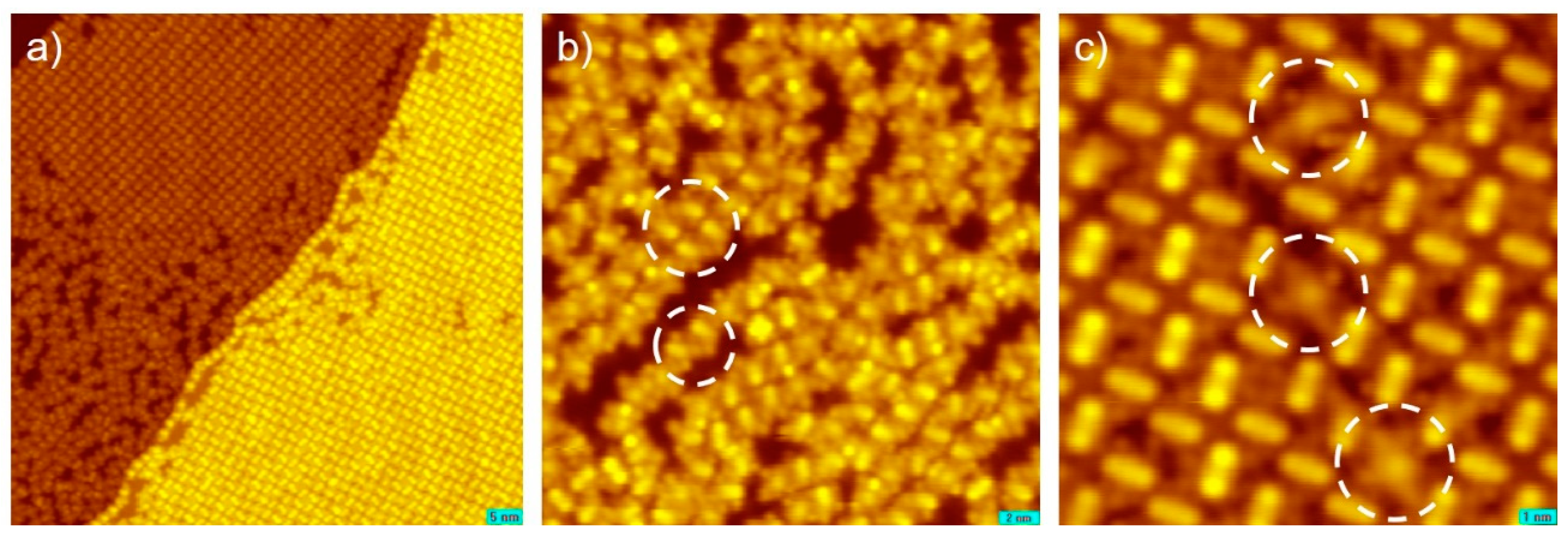
References
- Dong, L.; Liu, P.N.; Lin, N. Surface-activated coupling reactions confined on a surface. Acc. Chem. Res. 2015, 48, 2765–2774. [Google Scholar] [CrossRef]
- Klappenberger, F.; Zhang, Y.-Q.; Björk, J.; Klyatskaya, S.; Ruben, M.; Barth, J.V. On-surface synthesis of carbon-based scaffolds and nanomaterials using terminal alkynes. Acc. Chem. Res. 2015, 48, 2140–2150. [Google Scholar] [CrossRef]
- Wang, T.; Zhu, J. Confined on-surface organic synthesis: Strategies and mechanisms. Surf. Sci. Rep. 2019, 74, 97–140. [Google Scholar] [CrossRef]
- Clair, S.; de Oteyza, D.G. Controlling a chemical coupling reaction on a surface: Tools and strategies for on-surface synthesis. Chem. Rev. 2019, 119, 4717–4776. [Google Scholar] [CrossRef] [PubMed]
- Liu, J.; Chen, Q.; Cai, K.; Li, J.; Li, Y.; Yang, X.; Zhang, Y.; Wang, Y.; Tang, H.; Zhao, D.; et al. Stepwise on-surface dissymmetric reaction to construct binodal organometallic network. Nat. Commun. 2019, 10, 1–10. [Google Scholar] [CrossRef]
- Xing, L.; Peng, Z.; Li, W.; Wu, K. On controllability and applicability of surface molecular self-assemblies. Acc. Chem. Res. 2019, 52, 1048–1058. [Google Scholar] [CrossRef] [PubMed]
- Kang, F.; Xu, W. On-surface synthesis of one-dimensional carbon-based nanostructures via C–X and C–H activation reactions. Chem. Phys. Chem. 2019, 20, 2251–2261. [Google Scholar] [CrossRef] [PubMed]
- Held, P.A.; Fuchs, H.; Studer, A. Covalent-bond formation via on-surface chemistry. Chem. Euro. J. 2017, 23, 5874–5892. [Google Scholar] [CrossRef] [PubMed]
- Ruffieux, P.; Wang, S.; Yang, B.; Sánchez-Sánchez, C.; Liu, J.; Dienel, T.; Talirz, L.; Shinde, P.; Pignedoli, C.A.; Passerone, D.; et al. On-surface synthesis of graphene nanoribbons with zigzag edge topology. Nature 2016, 531, 489–492. [Google Scholar] [CrossRef]
- Jacobse, P.H.; van den Hoogenband, A.; Moret, M.-E.; Klein Gebbink, R.J.M.; Swart, I. Aryl radical geometry determines nanographene formation on Au(111). Angew. Chem. Int. Ed. 2016, 55, 13052–13055. [Google Scholar] [CrossRef]
- Haq, S.; Hanke, F.; Sharp, J.; Persson, M.; Amabilino, D.B.; Raval, R. Versatile bottom-up construction of diverse macromolecules on a surface observed by scanning tunneling microscopy. ACS Nano 2014, 8, 8856–8870. [Google Scholar] [CrossRef]
- Li, Q.; Yang, B.; Lin, H.; Aghdassi, N.; Miao, K.; Zhang, J.; Zhang, H.; Li, Y.; Duhm, S.; Fan, J.; et al. Surface-controlled mono/diselective ortho C–H bond activation. J. Am. Chem. Soc. 2016, 138, 2809–2814. [Google Scholar] [CrossRef]
- Zhang, X.; Xue, N.; Li, C.; Li, N.; Wang, H.; Kocic, N.; Beniwal, S.; Palotas, K.; Li, R.; Xue, Q.; et al. Coordination-controlled C-C coupling products via ortho-site C–H activation. ACS Nano 2019, 13, 1385–1393. [Google Scholar] [CrossRef]
- Zhong, D.; Franke, J.H.; Podiyanachari, S.K.; Blomker, T.; Zhang, H.; Kehr, G.; Erker, G.; Fuchs, H.; Chi, L. Linear alkane polymerization on a gold surface. Science 2011, 334, 213–216. [Google Scholar] [CrossRef] [PubMed]
- Chen, Q.; Cramer, J.R.; Liu, J.; Jin, X.; Liao, P.; Shao, X.; Gothelf, K.V.; Wu, K. Steering on-surface reactions by a self-assembly approach. Angew. Chem. Int. Ed. 2017, 56, 5026–5030. [Google Scholar] [CrossRef] [PubMed]
- Cirera, B.; Giménez-Agulló, N.; Björk, J.; Martínez-Peña, F.; Martin-Jimenez, A.; Rodriguez-Fernandez, J.; Pizarro, A.M.; Otero, R.; Gallego, J.M.; Ballester, P.; et al. Thermal selectivity of intermolecular versus intramolecular reactions on surfaces. Nat. Commun. 2016, 7, 1–8. [Google Scholar] [CrossRef] [PubMed]
- Liu, J.; Chen, Q.; He, Q.; Zhang, Y.; Fu, X.; Wang, Y.; Zhao, D.; Chen, W.; Xu, G.Q.; Wu, K. Bromine adatom promoted C–H bond activation in terminal alkynes at room temperature on Ag(111). Phys. Chem. Chem. Phys. 2018, 20, 11081–11088. [Google Scholar] [CrossRef] [PubMed]
- Xiang, F.; Gemeinhardt, A.; Schneider, M.A. Competition between dehydrogenative organometallic bonding and covalent coupling of an unfunctionalized porphyrin on Cu(111). ACS Nano 2018, 12, 1203–1210. [Google Scholar] [CrossRef] [PubMed]
- Tebi, S.; Paszkiewicz, M.; Aldahhak, H.; Allegretti, F.; Gonglach, S.; Haas, M.; Waser, M.; Deimel, P.S.; Aguilar, P.C.; Zhang, Y.-Q.; et al. On-surface site-selective cyclization of corrole radicals. ACS Nano 2017, 11, 3383–3391. [Google Scholar] [CrossRef] [PubMed]
- Cirera, B.; de la Torre, B.; Moreno, D.; Ondráček, M.; Zbořil, R.; Miranda, R.; Jelínek, P.; Écija, D. On-surface synthesis of gold porphyrin derivatives via a cascade of chemical interactions: Planarization, self-metalation, and intermolecular coupling. Chem. Mater. 2019, 31, 3248–3256. [Google Scholar] [CrossRef]
- Li, J.; Merino-Diez, N.; Carbonell-Sanroma, E.; Vilas-Varela, M.; de Oteyza, D.G.; Pena, D.; Corso, M.; Pascual, J.I. Survival of spin state in magnetic porphyrins contacted by graphene nanoribbons. Sci. Adv. 2018, 4, eaaq0582. [Google Scholar] [CrossRef] [PubMed]
- He, Y.; Garnica, M.; Bischoff, F.; Ducke, J.; Bocquet, M.L.; Batzill, M.; Auwarter, W.; Barth, J.V. Fusing tetrapyrroles to graphene edges by surface-assisted covalent coupling. Nat. Chem. 2017, 9, 33–38. [Google Scholar] [CrossRef] [PubMed]
- Song, H.; Fu, C.; Li, N.; Zhu, H.; Peng, Z.; Zhao, W.; Dai, J.; Xing, L.; Huang, Z.; Chen, W.; et al. On the shuttling mechanism of a chlorine atom in a chloroaluminum phthalocyanine based molecular switch. Phys. Chem. Chem. Phys. 2017, 19, 22401–22405. [Google Scholar] [CrossRef] [PubMed]
- Auwärter, W.; Seufert, K.; Bischoff, F.; Ecija, D.; Vijayaraghavan, S.; Joshi, S.; Klappenberger, F.; Samudrala, N.; Barth, J.V. A surface-anchored molecular four-level conductance switch based on single proton transfer. Nat. Nanotechnol. 2012, 7, 41–46. [Google Scholar]
- Hulsken, B.; Van Hameren, R.; Gerritsen, J.W.; Khoury, T.; Thordarson, P.; Crossley, M.J.; Rowan, A.E.; Nolte, R.J.M.; Elemans, J.A.A.W.; Speller, S. Real-time single-molecule imaging of oxidation catalysis at a liquid–solid interface. Nat. Nanotechnol. 2007, 2, 285–289. [Google Scholar] [PubMed]
- Gao, W.-Y.; Chrzanowski, M.; Ma, S. Metal–metalloporphyrin frameworks: A resurging class of functional materials. Chem. Soc. Rev. 2014, 43, 5841–5866. [Google Scholar] [CrossRef]
- Floris, A.; Haq, S.; In’t Veld, M.; Amabilino, D.B.; Raval, R.; Kantorovich, L. Driving forces for covalent assembly of porphyrins by selective C–H bond activation and intermolecular coupling on a copper surface. J. Am. Chem. Soc. 2016, 138, 5837–5847. [Google Scholar] [CrossRef]
- Yin, C.; Wang, Z.K.; Liu, D.; Peng, Z.T.; Song, H.J.; Zhu, H.; Chen, Q.W.; Wu, K. Adsorption and self-assembly of meso-tetra(p-methoxyphenyl)porphyrinatocobalt(ii) on coinage metal surfaces. Acta Chim. Sin. 2020, 78, 695–702. [Google Scholar]
- Karan, S.; García, C.; Karolak, M.; Jacob, D.; Lorente, N.; Berndt, R. Spin control induced by molecular charging in a transport junction. Nano Lett. 2018, 18, 88–93. [Google Scholar] [CrossRef]
- Ishizuka, T.; Saegusa, Y.; Shiota, Y.; Ohtake, K.; Yoshizawa, K.; Kojima, T. Multiply-fused porphyrins—Effects of extended π-conjugation on the optical and electrochemical properties. Chem. Commun. 2013, 49, 5939–5941. [Google Scholar] [CrossRef]
- Frisch, M.J.; Trucks, G.W.; Schlegel, H.B.; Scuseria, G.E.; Robb, M.A.; Cheeseman, J.R.; Scalmani, G.; Barone, V.; Petersson, G.A.; Nakatsuji, H.; et al. Gaussian 09 (Revision A.02); Gaussian, Inc.: Wallingford, CT, USA, 2016. [Google Scholar]
- Moreno-Lopez, J.C.; Mowbray, D.J.; Paz, A.P.; Ferreira, R.C.D.; dos Santos, A.C.; Ayala, P.; de Siervo, A. Roles of precursor conformation and adatoms in Ullmann coupling: An inverted porphyrin on Cu(111). Chem. Mater. 2019, 31, 3009–3017. [Google Scholar] [CrossRef]
Sample Availability: All samples are available from the authors. |
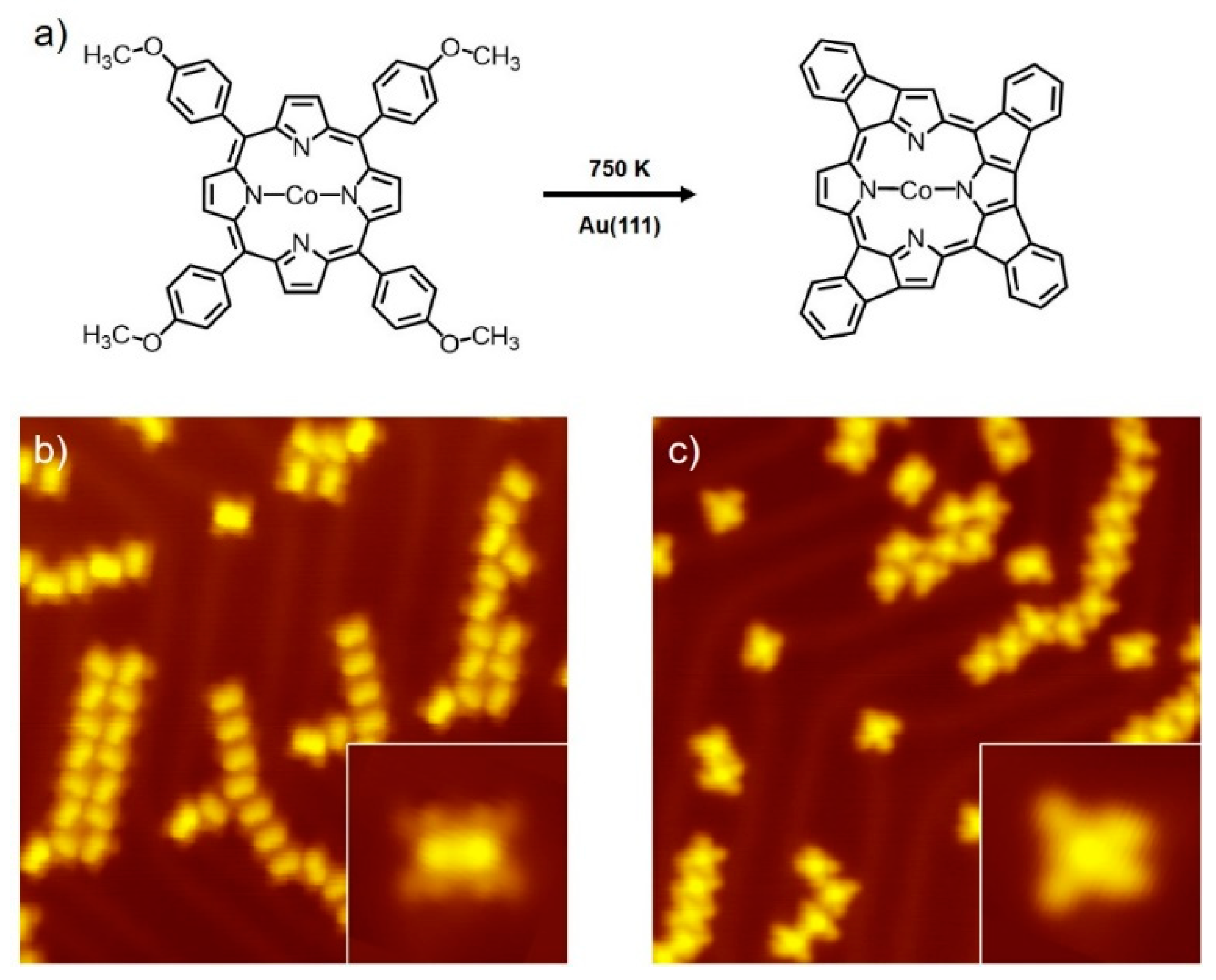
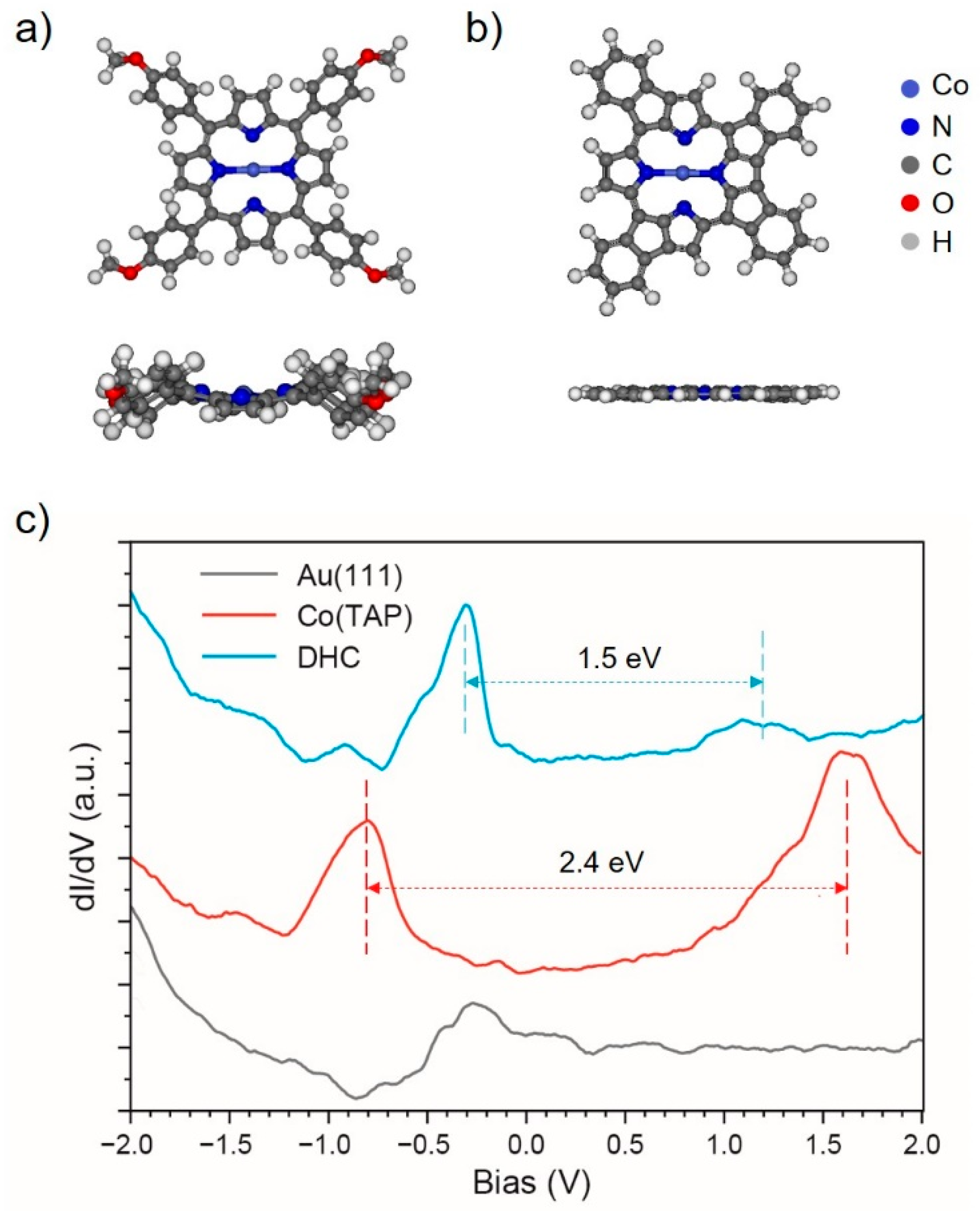
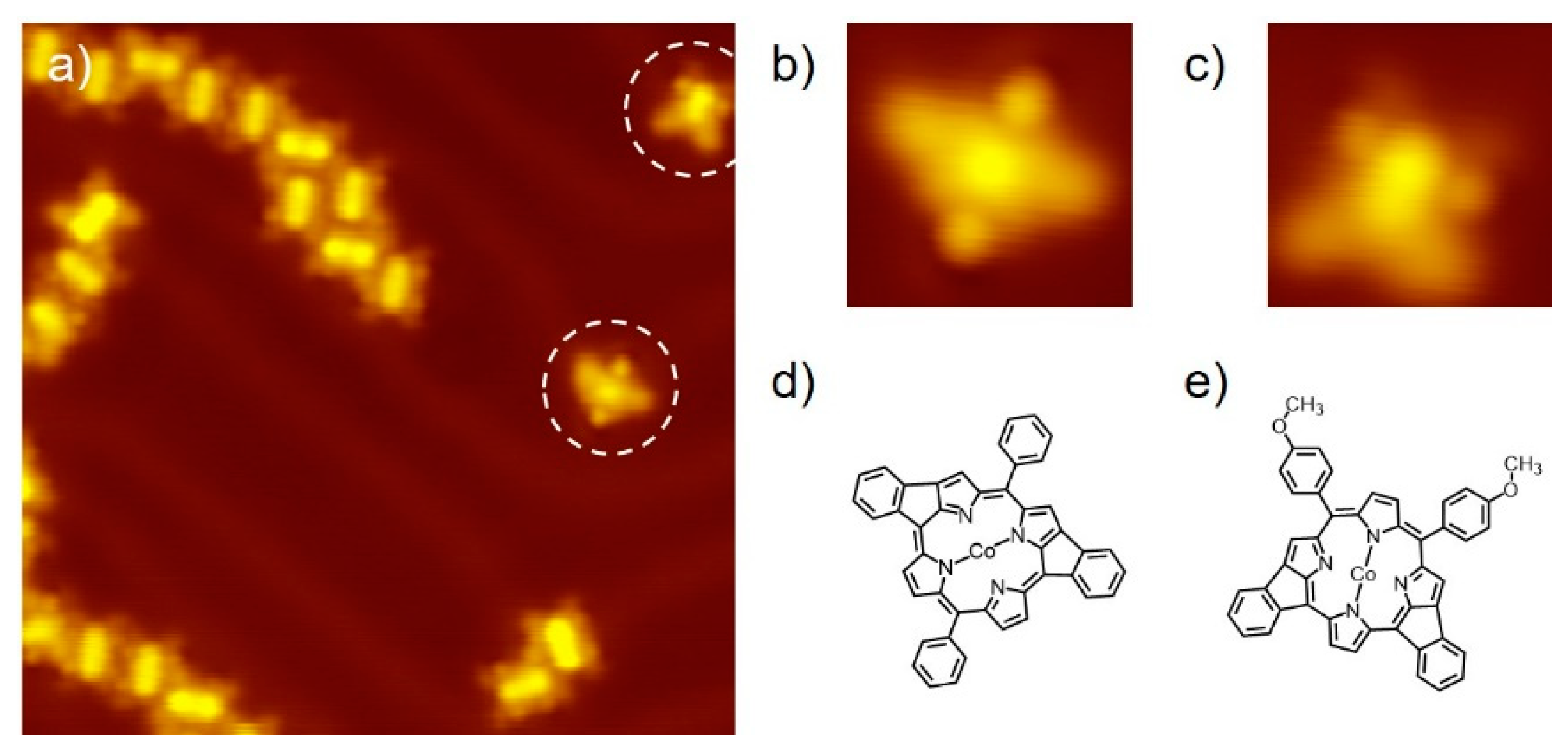
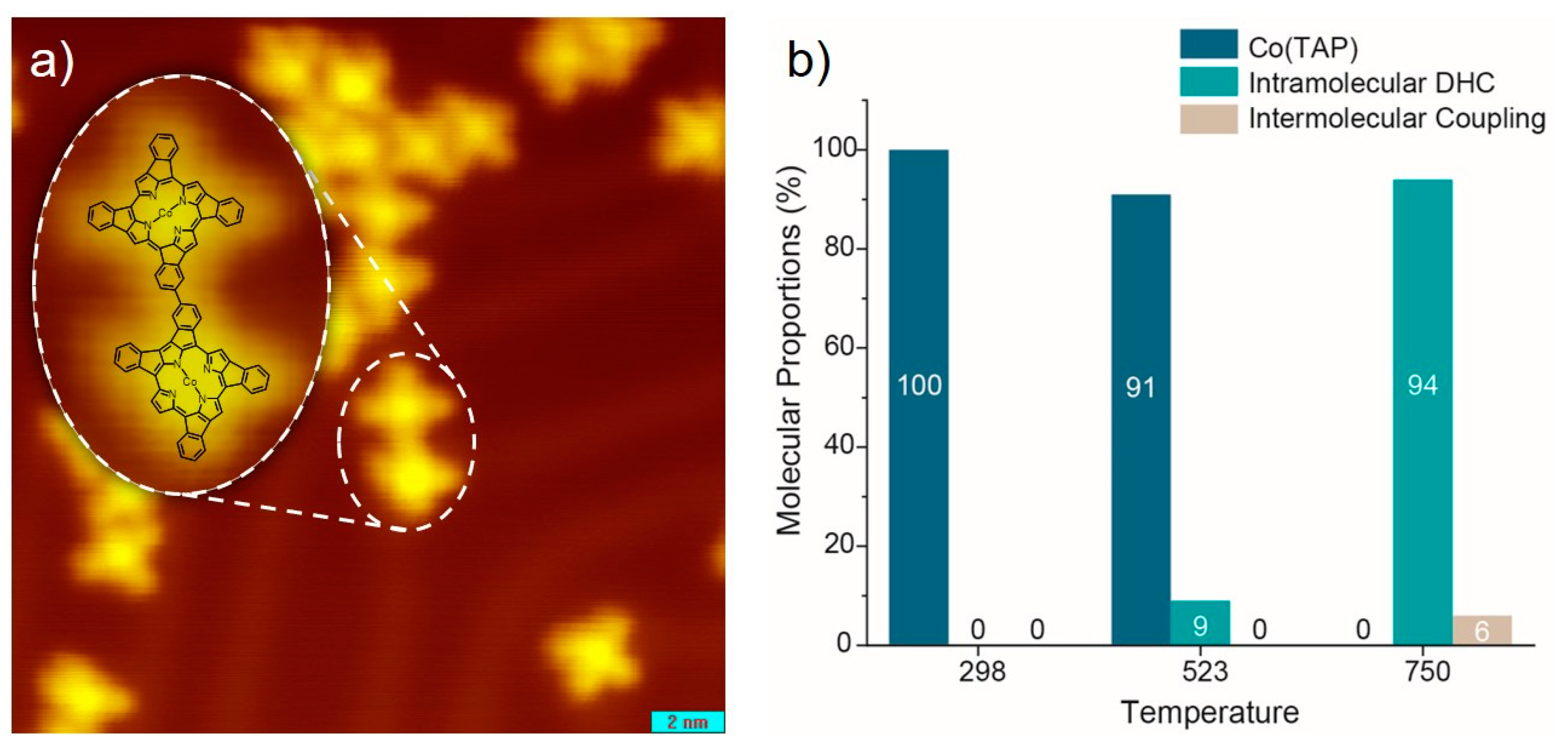
© 2020 by the authors. Licensee MDPI, Basel, Switzerland. This article is an open access article distributed under the terms and conditions of the Creative Commons Attribution (CC BY) license (http://creativecommons.org/licenses/by/4.0/).
Share and Cite
Yin, C.; Peng, Z.; Liu, D.; Song, H.; Zhu, H.; Chen, Q.; Wu, K. Selective Intramolecular Dehydrocyclization of Co-Porphyrin on Au(111). Molecules 2020, 25, 3766. https://doi.org/10.3390/molecules25173766
Yin C, Peng Z, Liu D, Song H, Zhu H, Chen Q, Wu K. Selective Intramolecular Dehydrocyclization of Co-Porphyrin on Au(111). Molecules. 2020; 25(17):3766. https://doi.org/10.3390/molecules25173766
Chicago/Turabian StyleYin, Cen, Zhantao Peng, Dan Liu, Huanjun Song, Hao Zhu, Qiwei Chen, and Kai Wu. 2020. "Selective Intramolecular Dehydrocyclization of Co-Porphyrin on Au(111)" Molecules 25, no. 17: 3766. https://doi.org/10.3390/molecules25173766
APA StyleYin, C., Peng, Z., Liu, D., Song, H., Zhu, H., Chen, Q., & Wu, K. (2020). Selective Intramolecular Dehydrocyclization of Co-Porphyrin on Au(111). Molecules, 25(17), 3766. https://doi.org/10.3390/molecules25173766





